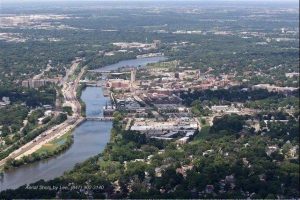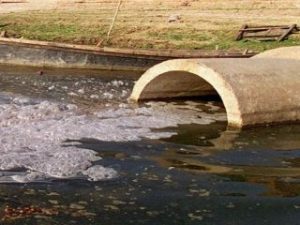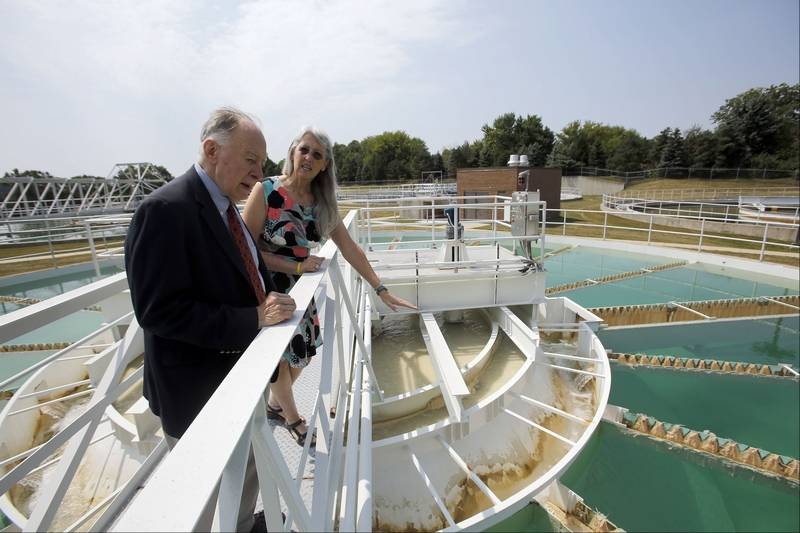By Kyla Jacobsen, FOFR Board Member
Years ago, people settled and communities grew up along rivers. People and animals had access to water and it was an easy way to transport goods by rafts or floats down the river. There were no dams back in those days and it allowed adequate fish passage, goods passage and boat travel.
Rivers Giveth
 Elgin was incorporated into a city in 1854. In the mid-1880’s, Elgin began providing water to the town as a community water system. At the time, the water was drawn from the Fox River and was conveyed to the businesses and residents via wooden water mains. The process of using local lakes and rivers for drinking water was becoming common around the country wherever there was a fresh water source. The water was just pumped out and used. Back then there was no water treatment as we know it.
Elgin was incorporated into a city in 1854. In the mid-1880’s, Elgin began providing water to the town as a community water system. At the time, the water was drawn from the Fox River and was conveyed to the businesses and residents via wooden water mains. The process of using local lakes and rivers for drinking water was becoming common around the country wherever there was a fresh water source. The water was just pumped out and used. Back then there was no water treatment as we know it.
And Rivers Taketh Away
Just as they provided a great way to get water and move goods along, rivers and streams also became a convenient way to discard waste.  Late in the 1800’s, there were several outbreaks of waterborne diseases like cholera and typhoid. Initially it was thought that these diseases were being spread by drinking out of a “common cup,” so that practice was eliminated from public places. Turns out the sharing of the cup was not the culprit spreading the diseases, but the water they were consuming was.
Late in the 1800’s, there were several outbreaks of waterborne diseases like cholera and typhoid. Initially it was thought that these diseases were being spread by drinking out of a “common cup,” so that practice was eliminated from public places. Turns out the sharing of the cup was not the culprit spreading the diseases, but the water they were consuming was.
Science to the Rescue!
Communities across the country had to find alternative drinking water sources since the rivers were polluted with disease-causing germs, and water treatment technology was in its infancy. It wasn’t until 1908 in New Jersey that chlorine was introduced in the United States as a disinfectant to water, thereby making it disease-free. Chlorine is still used around the world as a disinfectant and is heralded as one of the top 10 scientific breakthroughs of all time.
Cities and towns incorporated and began providing city services to residents and businesses. Due to the lack of water treatment capabilities, the water provided to the communities came from wells. This practice continues today. However, as communities, specifically here in northeastern Illinois, continue to grow, pumping water from the wells isn’t the “ever abundant supply” of water that was once envisioned. In order to provide water to the area now and in the future, communities with fresh water sources such as rivers and lakes, looked into treatment processes to determine the viability of those sources, once again, for drinking water.
Below the Surface
In the mid-1970s, Elgin’s population was rapidly growing. The 11 deep wells that were providing drinking water to the town were evaluated for sustainability. The city administrators were faced with a decision: drill additional wells to continue to supply water, or look to the Fox River as a drinking water source.
The Illinois Environmental Protection Agency was fairly new. Water regulations both on drinking water, and waters discharged to the waters of the state, were also fairly new. The Clean Water Act went into effect in 1972, when the EPA was formed, to regulate what could be dumped into “waters of the state”. For over a hundred years, people used the river as a dumping source for everything from human waste to industrial waste and garbage. Lakes, rivers and streams were so polluted that they could not be used for recreation, let alone drinking water.
Dirty Water
 Public perception was another hurdle that had to be overcome. The area residents were used to considering the Fox River as a “sewer receptacle” and didn’t want to think that they were drinking that water. By the time that Elgin began using the Fox River as the drinking water source, its water quality had improved exponentially. Industrial discharges were limited. Awareness of random dumping was in the limelight. Jim Phillips, aka “The Fox,” had brought to light the actions of many businesses that were polluting the river.
Public perception was another hurdle that had to be overcome. The area residents were used to considering the Fox River as a “sewer receptacle” and didn’t want to think that they were drinking that water. By the time that Elgin began using the Fox River as the drinking water source, its water quality had improved exponentially. Industrial discharges were limited. Awareness of random dumping was in the limelight. Jim Phillips, aka “The Fox,” had brought to light the actions of many businesses that were polluting the river.
Making Water Clean Again
 Water treatment technology had come a long way in the last hundred years and the Illinois EPA was helping to clean up the Fox River by placing regulations on dischargers. The City of Elgin decided to turn to the Fox River once again as a drinking water source. Several years of testing the river water, testing the treatment processes, and getting permits for the water withdrawal, led Elgin to break ground on the Leo Nelson Riverside Water Treatment Plant in May of 1979. The plant was fully operational by 1981 and the plan was to maximize the use of the river for the drinking water supply.
Water treatment technology had come a long way in the last hundred years and the Illinois EPA was helping to clean up the Fox River by placing regulations on dischargers. The City of Elgin decided to turn to the Fox River once again as a drinking water source. Several years of testing the river water, testing the treatment processes, and getting permits for the water withdrawal, led Elgin to break ground on the Leo Nelson Riverside Water Treatment Plant in May of 1979. The plant was fully operational by 1981 and the plan was to maximize the use of the river for the drinking water supply.
Drinking the Fox
The water quality in the Fox River makes it an excellent source for drinking water. It does not have heavy metals or the pesticide contamination that it once had. The biggest threat to the river water quality is still us. The overabundance of nutrients (phosphorous and nitrogen) causes algal blooms and oxygen deficiencies which can damage the ecosystem of the river.
Currently the city of Elgin pulls approximately 85% of the total water supplied from the Fox River. Elgin supplies water to its residents as well as the Village of Sleepy Hollow and a portion of the Village of Bartlett. The city of Aurora also uses the Fox River as its drinking water source. Today, nearly 350,000 people in the watershed get their drinking water from the Fox River.


